Table of Contents
Introduction: General Considerations
Nothing like the feeling of freedom in an outdoor gym, in a backyard or on a patio, in fresh air and sunlight. It’s possible to keep your gym equipment in reasonably good shape even outdoors.
The main issue is rain or even nighttime dew. If it’s outside, it will get wet, leading steel parts to rust. Secondarily, rubber, vinyl and plastic could suffer from UV damage without proper care.
The most basic thing you can do is to situate things in a way where a minimal amount of material is sitting on the ground/concrete where water can pool up on at the feet. That’s what will cause it to rust quickly. If water can drip off it’s much better.
An open-air gym, covered by a roof, brings far less potential for rusting or UV damage than a gym totally exposed to the elements. Moisture can still get blown in from rain mist. Overall it’s nearly as protected as a garage gym.
Weight Bench
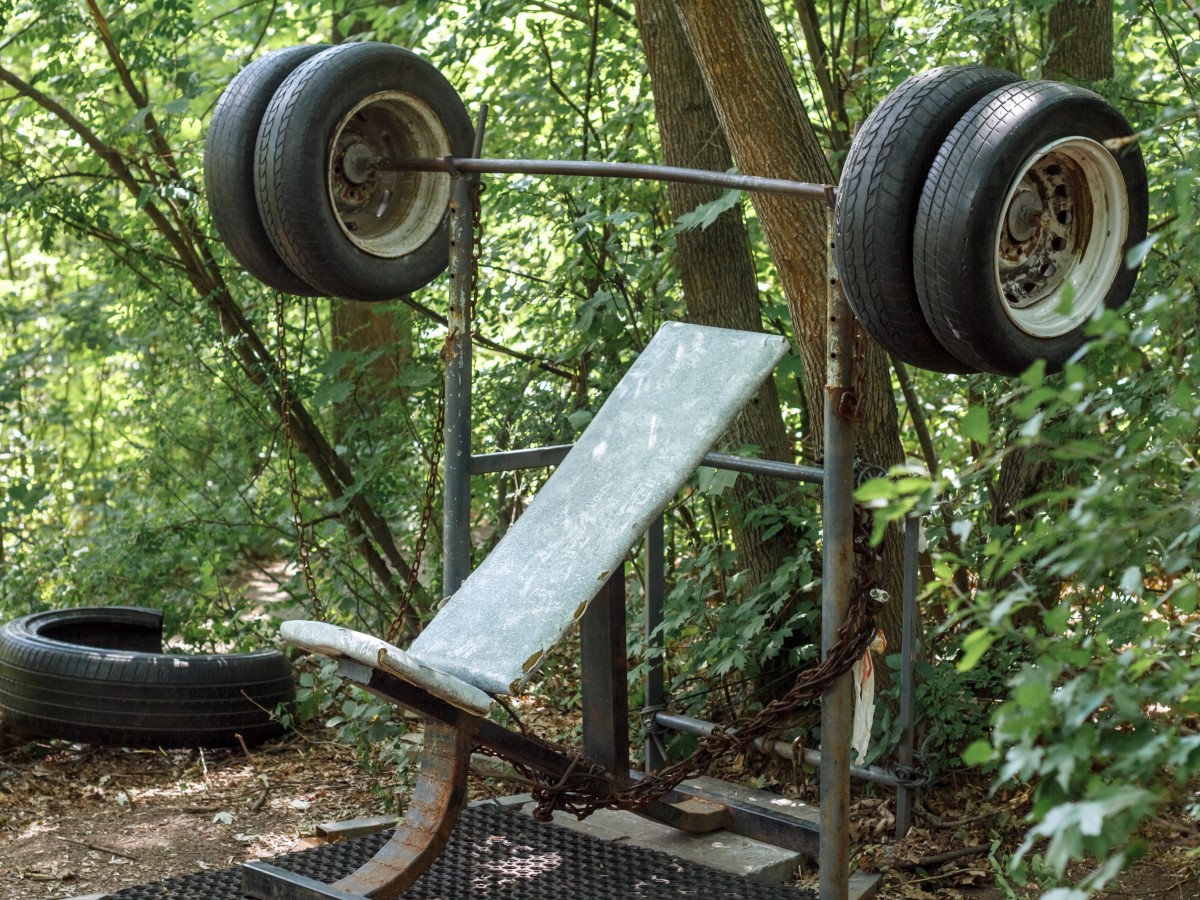
Keep the vinyl on your bench in better shape than the one above by spraying on protectant.
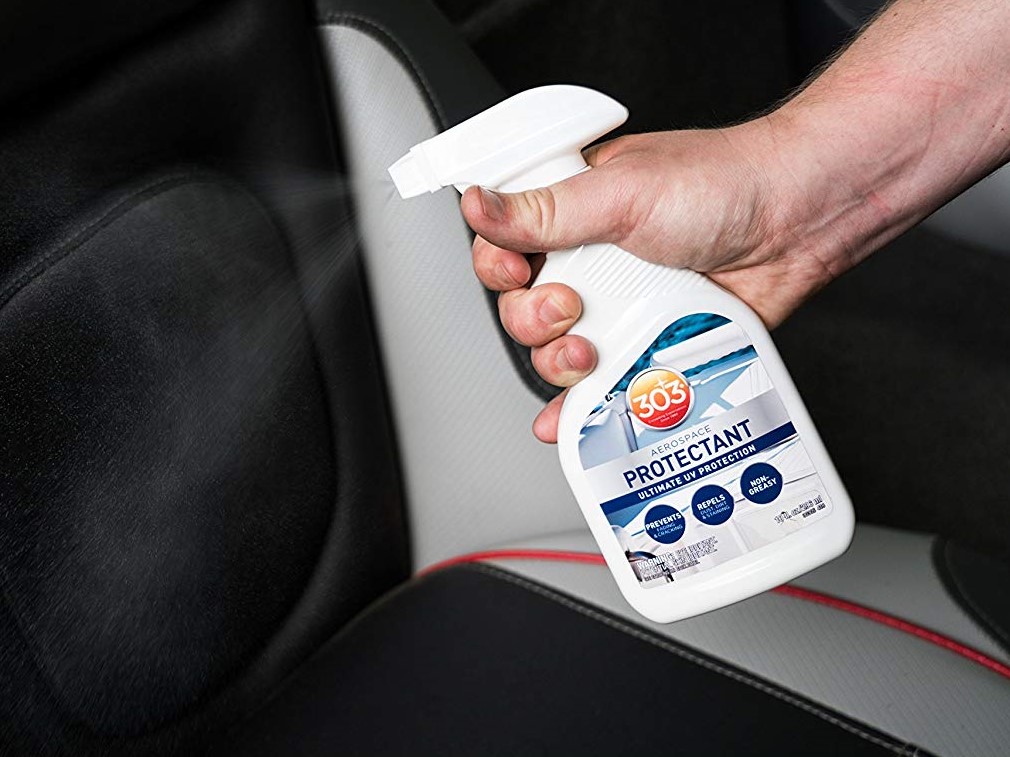
303 Aerospace Protectant is well-known for its effectiveness on the surfaces of anything exposed to the elements. It will protect vinyl upholstery on weight benches and help seal the seams against moisture creeping in. It’s also good for any rubber or plastic. It goes on “dry” without a slimy residue.
Wipe the steel frame down once a month with mineral oil or 3-in-One Oil. Keep an eye on any spots where the paint is rubbing off, particularly on the bar catches if they don’t have UHMW plastic liners to protect them and the bar, and use touch up paint as needed.
Power Rack
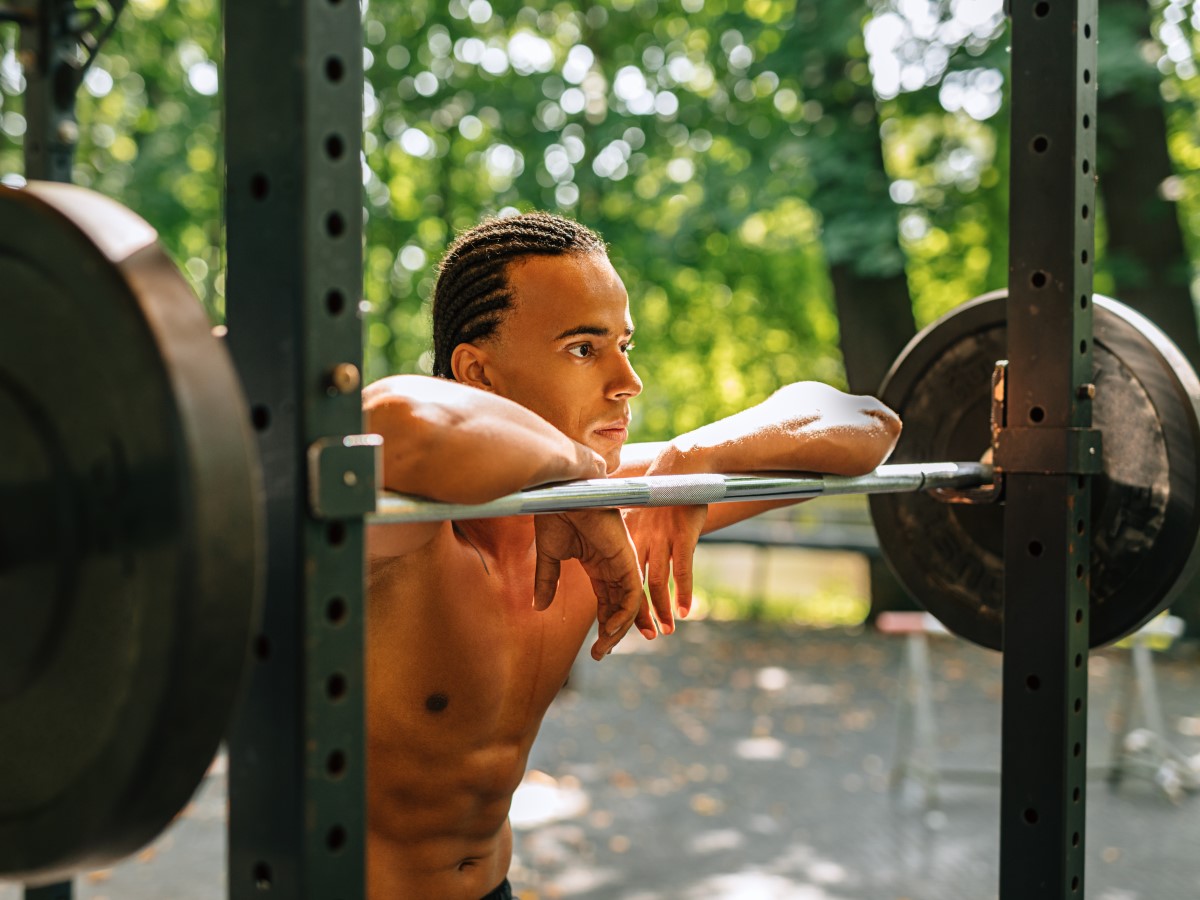
Spray all exposed parts of nuts and bolts with a enamel paint – a matte clear coat will look the best if you can’t match the rack’s color exactly – to give them extra protection. They are likely to rust before anything else, given the scratches on them from being tightened. Don’t spray them before assembly, or they might be hard to tighten.
For any kind of power rack or squat rack used outdoors, the paint company Eastwood has a spray bottle of interior frame coating, with a tube that’s perfect for sticking inside the holes on the uprights of the power rack. Cover all the rack holes with some painter’s tape, poke the tube into a small hole you make in one piece of the tape in one hole (you don’t want the paint to spray back out), and give it a good spray all over the inside. It takes some guesswork in aiming the tube. Do it through at least a couple holes to be sure you’re coating the inside. Truthfully, I think you could use any enamel paint. It’s the spray tube that’s key.
If the rack is exposed to the rain, or to significant mist in stormy weather, drill small holes into the lowest part of the uprights so that water can drain out.
As far as the outside of the rack, it’s the same as a bench frame as described above. Wipe the steel down once a month with mineral oil or 3-in-One Oil. Very little oil is needed, and you can wipe it off pretty well for a thin coating. Keep an eye on any areas of paint being rubbed away and touch it up, like where your power rack attachments rub against the uprights. This is where high-quality attachments will help that have UHMW plastic to contact the rack’s uprights instead of steel-on-steel.
If you’re using safety straps in lieu of safety bars, I would spray them with the 303 protectant mentioned to stop the UV from getting in and weakening them.
Ideally, throw a tarp over the squat rack to cover it between workouts.
Barbells
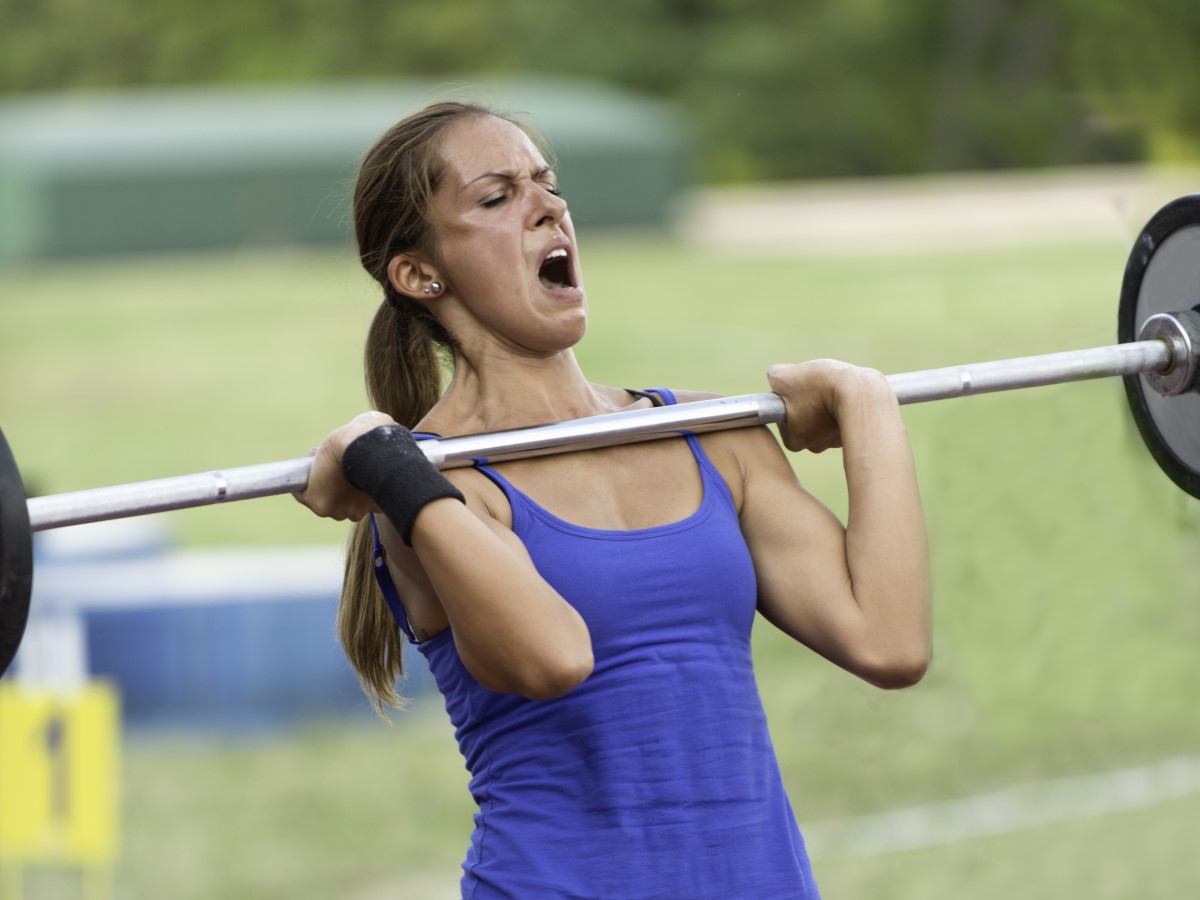
If you want to care for one thing, it’s the bar. You can let everything else rust if you don’t care enough. But take care of your bar. I wrote a long post on preventing rust on olympic bars, and it applies doubly here. Take the steps outlined in that post.
A stainless steel bar does the best outdoors and does not require any maintenance on the shaft. The worst is a bare steel bar, and the next worst is a black oxide or zinc coating that is okay at first but can start to wear off a little and allow moisture to touch the steel.
Most importantly, keep moisture out of the sleeves so they can continue to spin like new. Spray WD-40 on that area around the ends of the shaft to repel water. If you have some kind of fabric sleeve to cover the bar sleeves, or the whole bar, that could be handy. Otherwise, at least drape a tarp over it to stop most moisture and prevent birds from crapping directly on it (nice perch).
Consider bringing your bar into some covered area for storage between workouts and avoid much of the hassle of maintenance. It’s the one piece you want to keep in good shape.
Bumper Plates or Rubber Coated Plates
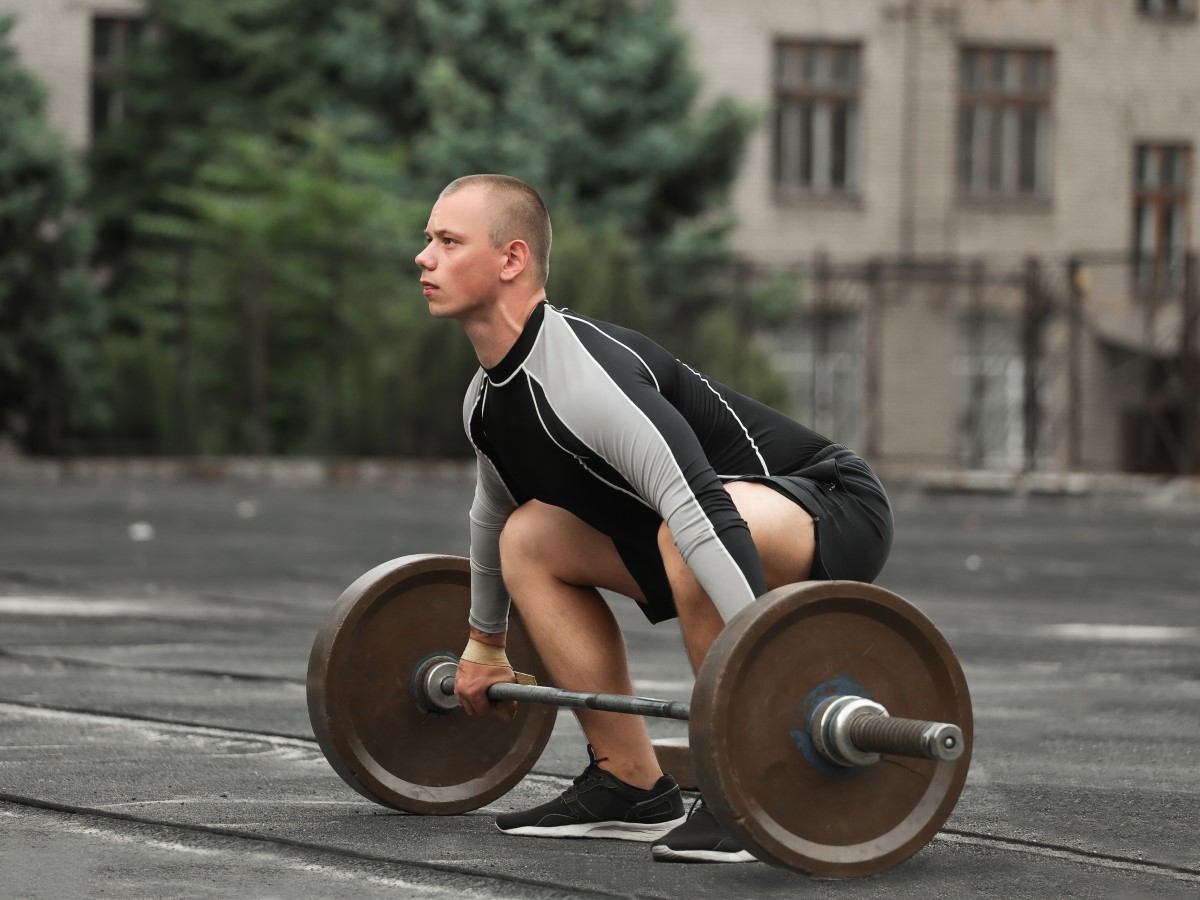
Rubber expands and shrinks in the heat and cold, leading to premature degradation. It’s not ideal for outdoors. Urethane doesn’t have that problem but is expensive.
Coat the rubber with 303 Protectant as described above for the weight bench.
For any non-coated iron in the center hole of rubber coated plates or urethane coated plates, rub mineral oil or 3-in-One oil over it, even if it’s painted, and wipe it dry so there’s no excess to get on your skin. A light coating will remain. Bumper plates use a stainless steel hub, which prevents rust pretty well.
Iron Plates, Dumbbells and Kettlebells
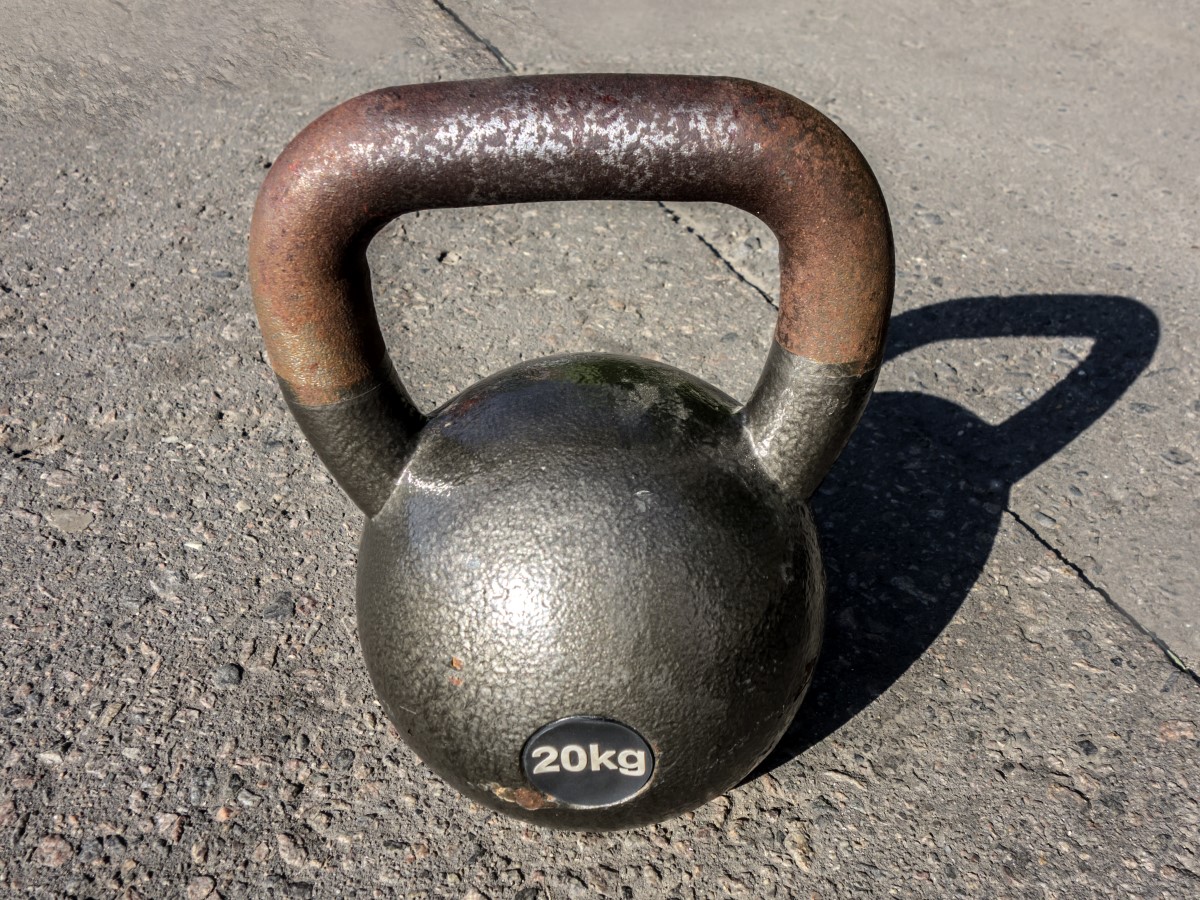
Any kind of iron weights need to start with a good paint job. For older weights that need some work in that department, see more info about that in the weight plates restoration article. It applies pretty much the same to kettlebells and iron hex dumbbells.
Rub mineral oil or 3-in-One oil with a rag all over any painted iron surfaces, and wipe dry so there’s no excess to get on your skin. A light coating will remain that you won’t really feel. The oil along with the paint underneath should do a good job.
Spray and wipe any rubber surfaces with 303 Protectant as described for other equipment.
Keep them on some kind of rack that water will drain off of, or drill drain holes in the rack. Plates are easily stored on a plate tree. A small number of kettlebells can sit on any kind of wood shelf or grate easily enough.
Weight Machines and Cardio Equipment
Any piece of equipment with moving parts could run into a problem if left without care. Moisture will get in the cracks between the moving parts, and rust will form. It’s best to cover it with a tarp between every workout.
Cardio machines as a rule do badly outside. The smooth movement is critical, and any water or dirt getting in will mess it up.
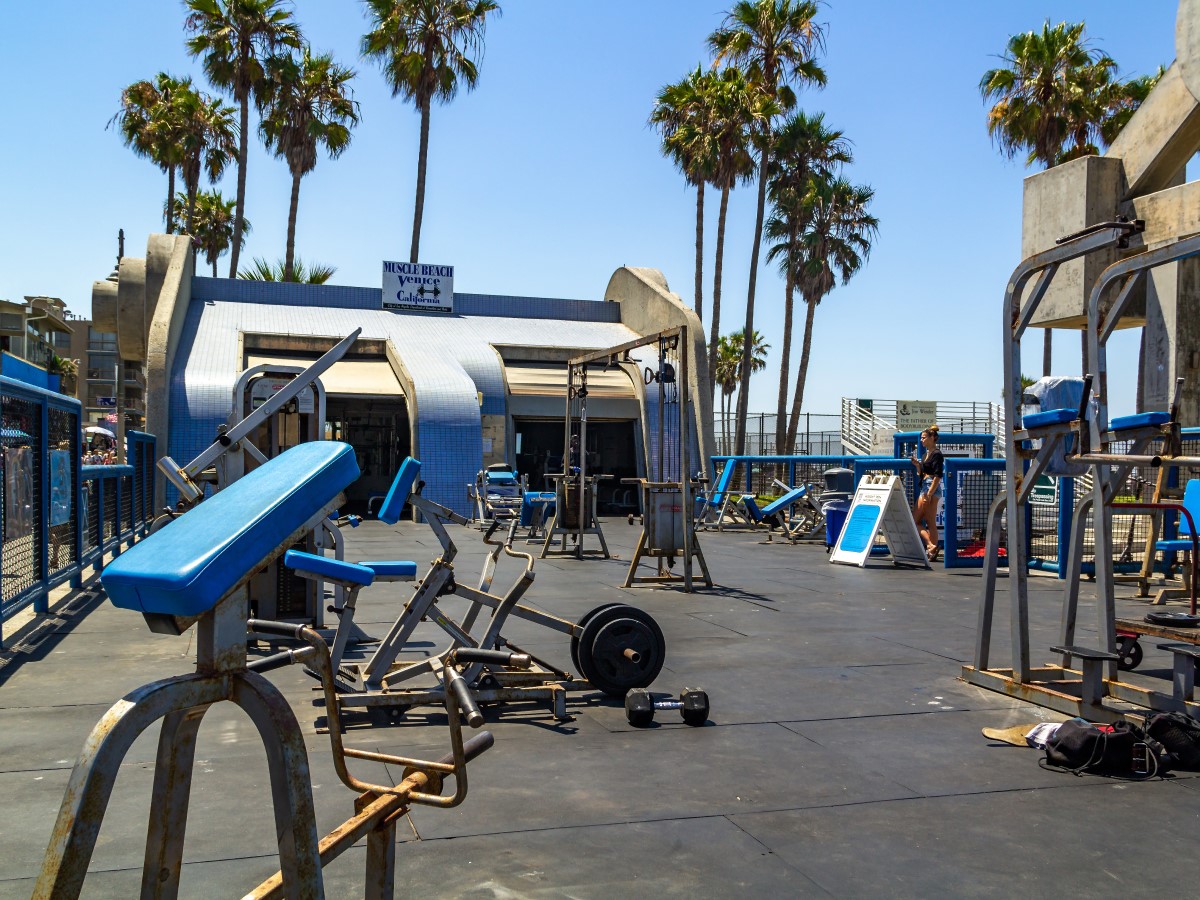
Some weight equipment may last for many years. Muscle Beach is a famous spot that for decades has had an outdoor gym full of machines, right next to the ocean, where the machines obviously show some rust and have fared okay.
Covers
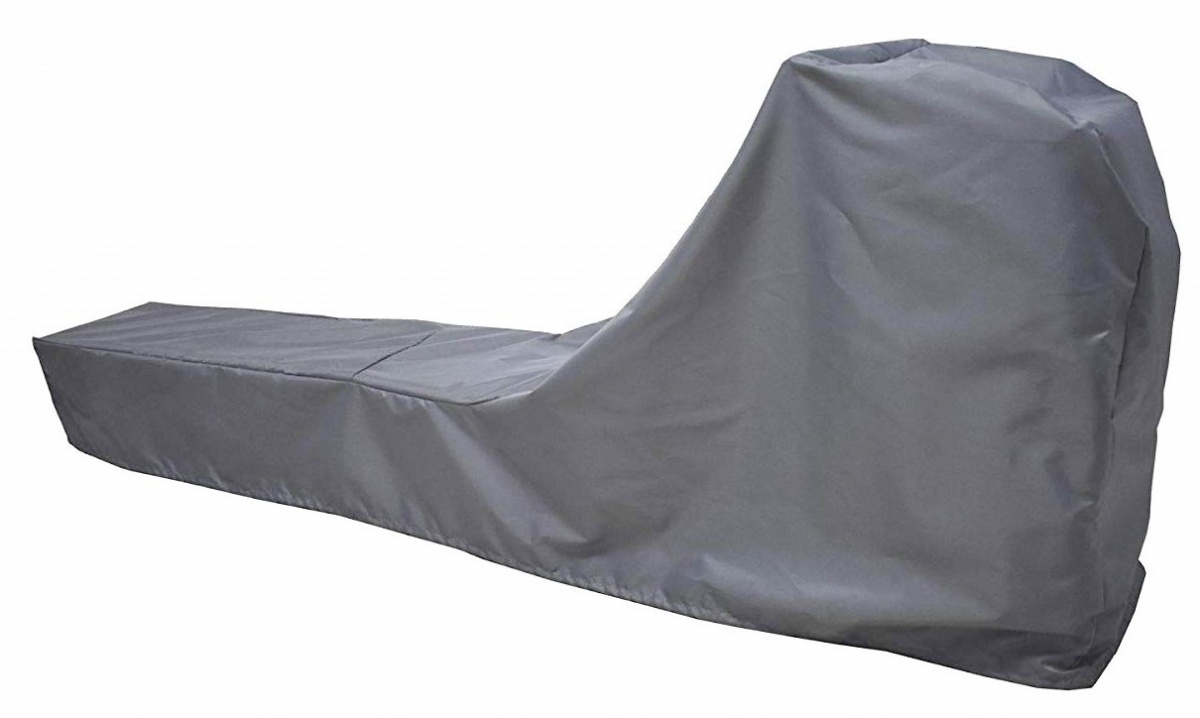
There are covers you can get for cardio equipment, like the above waterproof cover that fits the Concept2 model D and E rower.
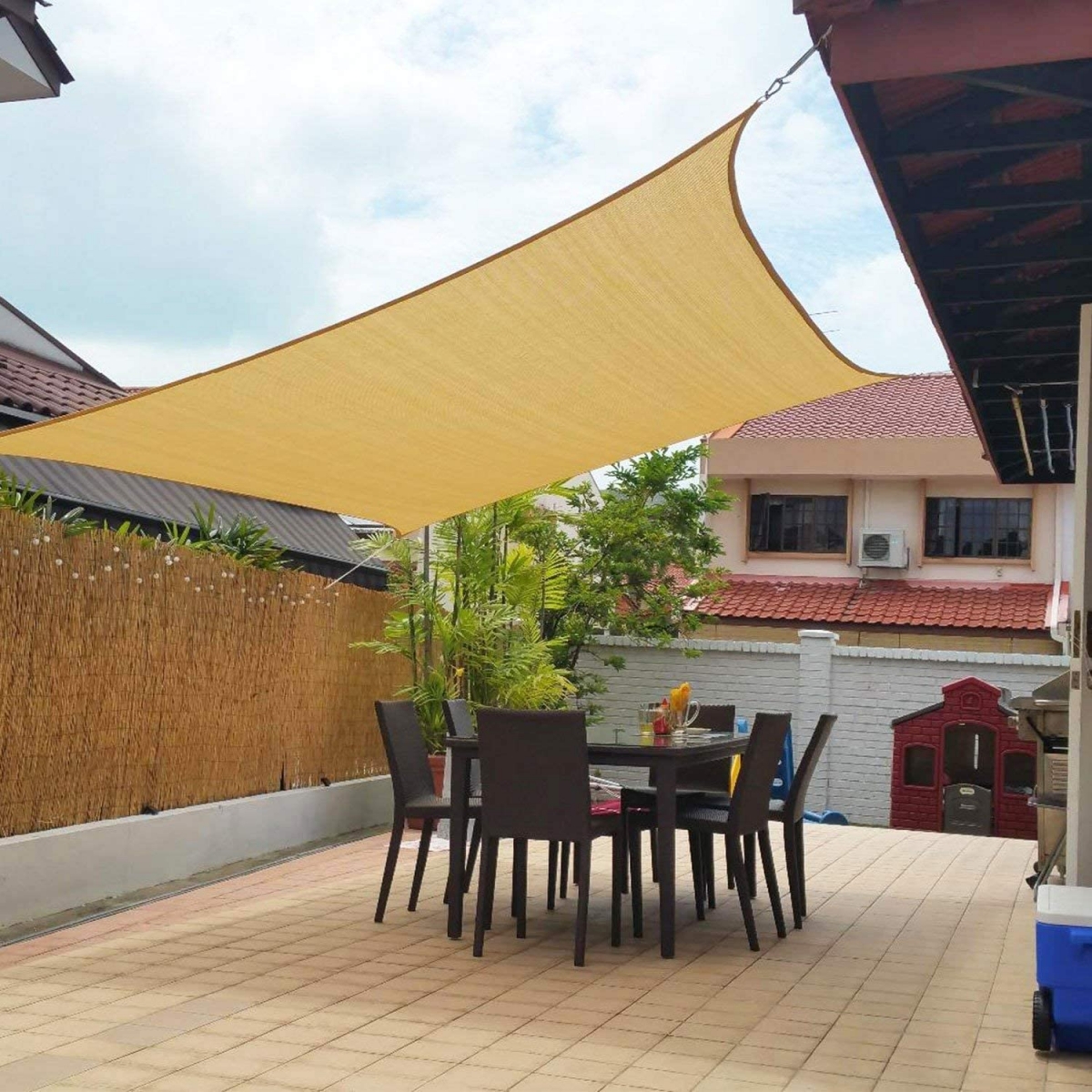
If you have things to tie it to, a large water-resistant shade like the above could do the trick for your gym area. Obviously some rain could blow in.
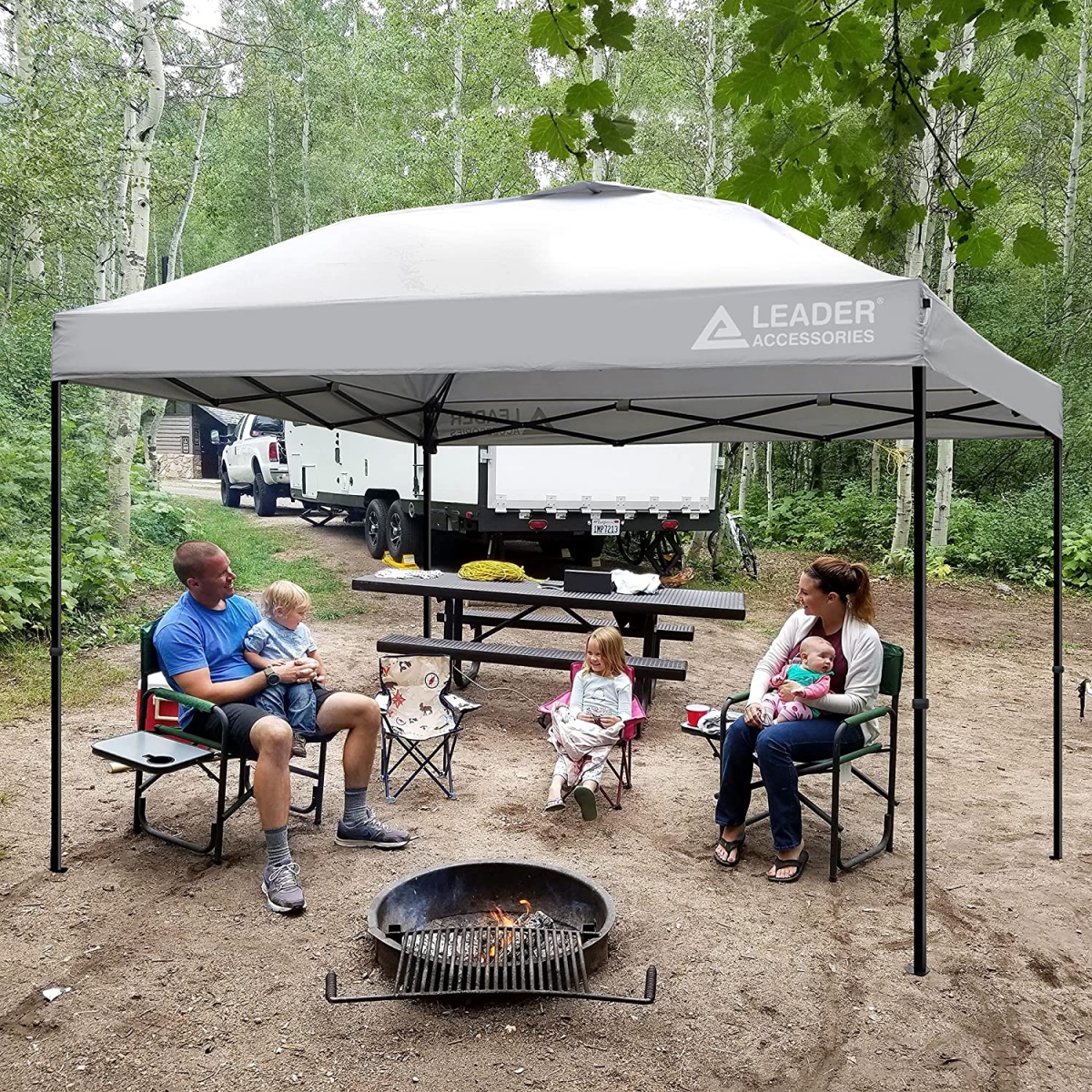
A whole standalone canopy tent like the above would be ideal, but unfortunately these are hard to find in a height suitable for overhead pressing, etc.

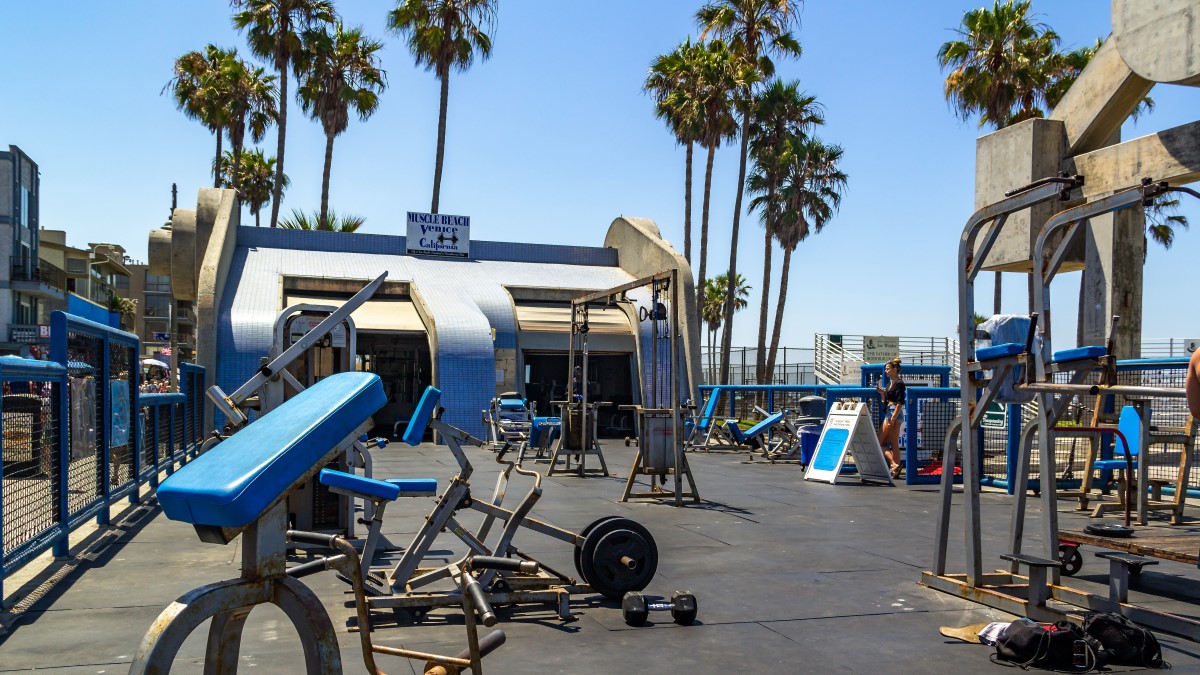

David, about the interior frame coating. I have a rack that’s been outside for a few years–covered by a tarp, but has gotten some rust that i can see on the interior. Is there a way to ‘clean’ that, or do i need to before applying the coating?
Hi, thanks for this. Anyone using cardio equipment in the garden with covers. Want to know if it stays ok for years, especially those machines that run on electricity. With waterproof covers on, does dust and moisture damage them or do they stay ok for years? Am in the UK
Waterproof covers are important. Dust shouldn’t matter much in most places. The other issue is hot trapped air will condense when cooled and cause rust, but that’s mainly when hot air is sealed into a relatively airtight container. A little room for airflow will avoid that. Good question! I will have to add a bit about this in the article.
This is a great article, thanks for the tips & encouragement. I live in Seattle where it can stay grey and miserable a lot of the year but this has got me thinking about ways to make it happen. I’m mainly looking to get a leg press/hack squat machine set up.
On the topic of tarps/overhead coverings, I set up a large outdoor space for hanging out with friends during the pandemic over the winter. For the overhead covering I used repurposed old vinyl billboards you can get from this company Billboard Vinyls.
https://www.billboardvinyls.com/
My first choice would’ve been sunbrella but they’re darn expensive, then I thought about army-treated canvas but that was pricey or messy as diy. Ended up in the middle with this billboard place – the advertisers who put them up originally all put the waterproofing/UV protection on them, so you’re just paying the aftermarket price. I think mine was 36’ x 12’ for like $120 maybe? Enough to drape down the sides of a structure. I did pay extra to put grommets in to string it up. Good solution overall though.
Those look like a great deal for the square footage you get. I’m going to add it to the article! I imagine it might need grommets installed or something to secure it well.
Been searching for a canopy tent to cover my outdoor rack and can’t find any. They’re all too short. I need 7.5′ clearance. I also want the side drapes to go all the way down to the ground to prevent rain from blowing in. Having to make it myself. What a pain.
Have you found anything? I have the same problem currently.
https://www.costco.com/10'-x-20'-steel-frame-canopy.product.100768239.html
We used this Carport from Costco. Works great if you put the power cage in the middle back.
Have you had any big storms since you put up your carport? I had something similar, but it crumpled in a couple of places, and it wasn’t recoverable
would polyurethane work?
Do any of you know of free weights, dumbbells, benches, or racks designed for outdoor use and storage? With gyms having moved outdoors during this crazy past year, surely someone has rolled out element resistant product. This would be a product line whose time has come!
I haven’t seen much aside from DIY wooden power racks and benches that work pretty good outdoors. Now that I think about it, there are some stainless steel kettlebells and urethane dumbbells with stainless steel handles that I should look through and add notes on here.
Was nervous about plan to put a rack outside since not enough room in garage. Thank you for the helpful tips David
Let me know how the outdoor gym goes after a while!
Didn’t even occur to me that I would have to protect the inside of the rack from rust! Thanks for the info.
Hopefully your rack stays rust free!
Re: Outdoor Home Gyms: How to Avoid Rust or UV Damage
Hello David, thank you for these helpful tips. I have a great Hoi*$t weight gym cage with multiple stations that was gifted to me. Because it was so darn heavy,the neighbor said” If you can remove it safely, it’s yours!”Went online to find out this model sold for about $4,000 back in the eighties.
I was told that WD 40 is no longer the same quality product it used to be. When the company was sold years ago they cheapened the formula and rode the name for continued sales. My car guru buddy stated there is now kerosene in the spray can of WD40 which actually promotes rust over time when the lubricant evaporates. Do you have any thoughts or ideas to share?
I want to tarp my equipment. Thinking of that Su**brella material and have my car upholstery guy make a cover out of it.
Thank you again for addressing this important issue as moisture is everywhere on planet earth.
That’s a good score as a free unit of that size. Congrats! I looked up the WD-40 kerosene issue, and I think it’s a myth unless your friend has some way to know for sure? My impression is WD-40 can be a good first thing to use to clean things up and get things moving, but it doesn’t last a long time as a protectant, making it a good idea to follow up with oil or grease when there’s moisture potential.
Any reason you’re censoring out the word Hoist and I’m guessing Sunbrella? It’s fine to talk about brands.
It’s a myth. “WD”, in WD-40, literally means Water Displacement. It was the 40th formula of the fluids they tried. It is good to use. Nothing works better than a good metal style paint job with 100% coverage.